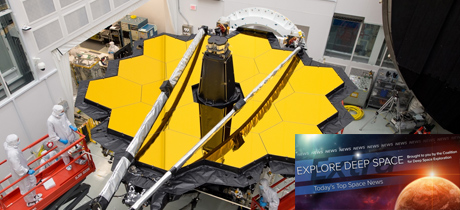In Today’s Deep Space Extra… NASA promises to address a new delay and cost increase in the technically challenging development of the James Webb Space Telescope (JWST), which is now set for launch on March 30, 2021. New research identifies organic molecules in the eruptive spray rising from Saturn’s ice and ocean covered moon Enceladus as sampled by the NASA/European Space Agency Cassini mission.
Space Policy
House Committee clears civil space situational awareness legislation
Spacepolicyonline.com (6/28): The U.S. House Science, Space and Technology Committee approved legislation on Wednesday supporting a White House move to place space situational awareness and space traffic management responsibilities for commercial and civilian government operations from the U.S. Department of Defense to the Commerce Department. The transition, which will take some time to implement, was the focus of President Trump’s Space Policy Directive-3, signed on June 18. The DOD and Commerce are required to provide a transition plan to lawmakers.
Human Space Exploration
CRS-15 resupply mission sending artificial intelligence, diverse science to ISS
Spaceflightinsider.com (6/27): Set to liftoff early Friday from Cape Canaveral Air Force Station, Florida, the next NASA contracted International Space Station (ISS) resupply mission is to deliver nearly three tons of research experiment, tech demonstrations and crew supplies. Among the new science hardware, is a Center for the Advancement of Science in Space (CASIS) sponsored U.S. National Lab experiment to explore new capabilities for an artificial intelligence device, CIMON. CIMON, designed by Europe’s Airbus, is to interact with astronauts in space, offering them an information resource. Liftoff of the SpaceX cargo mission is set for Friday at 5:42 a.m., EDT, with arrival at the Space Station early Monday.
Space Science
Much-delayed James Webb Space Telescope (JWST) gets delayed yet again to 2021
Coalition Member in the News – Northrop Grumman
Spacepolicyonline.com (6/27): Launch of the JWST, successor to the Hubble Space Telescope, is re-set for March 30, 2021, the latest in a recent series of setbacks that previously anticipated May 2020 as the likely launch period. The price tag for the development cost and five year primary mission also rises from $8.8 billion to $9.6 billion. That includes a breach of the $8 billion development cost cap established by Congress in 2011, which will force lawmakers to re-authorize the program if it is to continue. The changes result from the findings of a fast paced independent review led by Thomas Young, the retired Lockheed Martin and NASA executive. The review panel’s report, released Wednesday, made 32 recommendations to help NASA and Northrop Grumman, the JWST’s prime contractor, overcome a series of technical challenges. NASA is already at work on their implementation. The advanced space observatory is to study the formation of the earliest star systems and seek signs of bio signatures in the atmospheres of extra solar planets.
Administrator Bridenstine: NASA is committed to JWST
NASA/YouTube (6/27): NASA Administrator Jim Bridenstine discusses the agency’s commitment to completing the James Webb Space Telescope (JWST) mission despite a new round of pre-launch difficulties. “We are creating something new here,” notes Bridenstine.
Our solar system’s first known interstellar object gets unexpected speed boost
NASA/Goddard (6/27): One of astronomy’s surprise discoveries of 2017 was Oumuamua, a large planetary object with origins beyond the solar system that sped through the solar system. Observations with the Hubble Space Telescope and ground observatories reveal that more than gravitational tugs from the sun and planets altered Oumuamua velocity and heading. The changes were likely due to jets of material coming from Oumuamua, according to a new study led by U.S. and European scientists.
Saturn moon Enceladus is first alien ‘water world’ with complex organics
Space.com (6/27): Saturn’s eruptive, ice and ocean covered moon, Enceladus, is home to organics, the molecular building blocks for life, some of them complex, according to a study led by a German researcher. The findings come from the long running U.S./European Cassini mission that orbited giant, ringed Saturn between July 2004 and September 2017.
Other News
Commercial laser comm edges closer to reality
Space News (6/26): Bridge Sat, of Denver, Colorado, plans to build 10 ground stations to advance a new optical communications concept that could find a commercial footing in support of low Earth orbit satellite communications. All 10 ground stations are to be in place by the end of next year, the first near Fresno, California.

